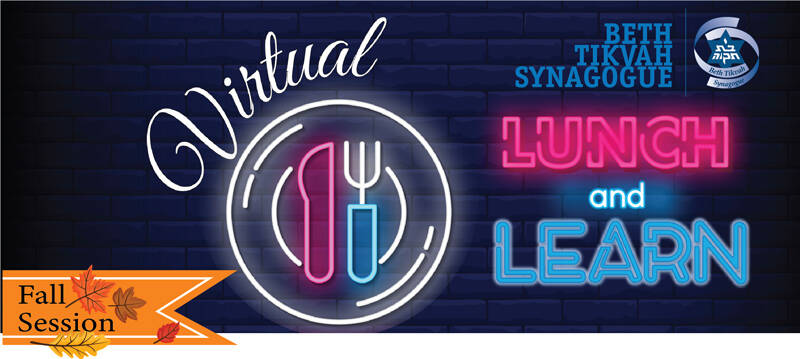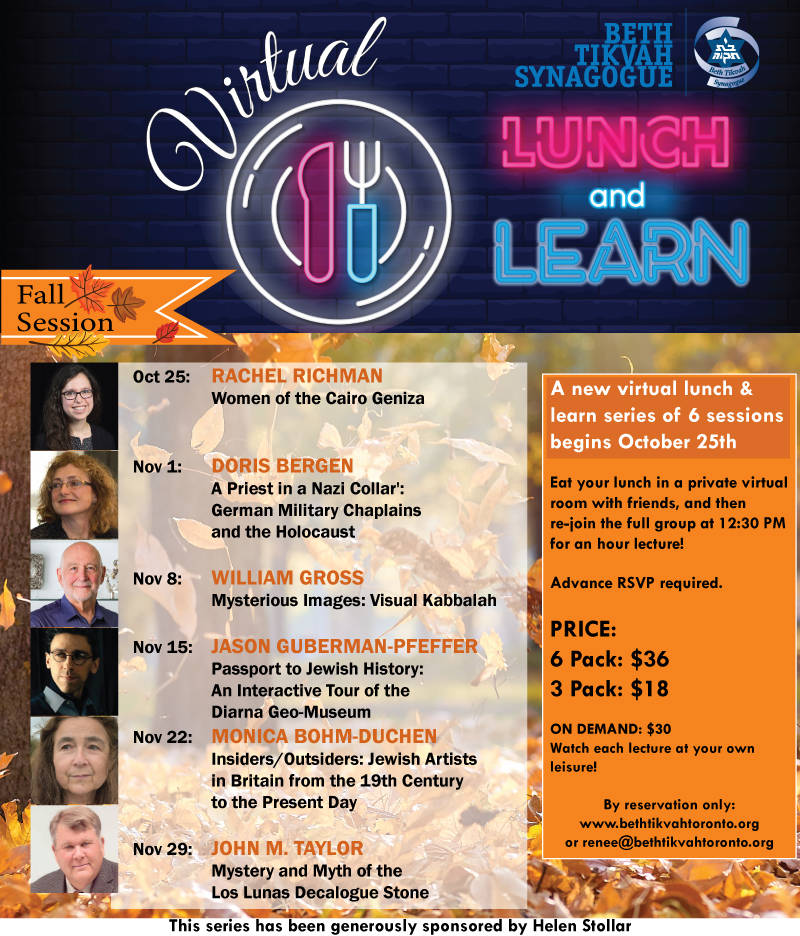
Lunch and Learn Fall 2022
Past SessionsTuesday, 29 November, 2022 • 5 Kislev 5783 - 12:00 AM - 2:00 PM
Tuesday, 22 November, 2022 • 28 H̱eshvan 5783 - 12:00 AM - 2:00 PM
Tuesday, 15 November, 2022 • 21 H̱eshvan 5783 - 12:00 AM - 2:00 PM
Tuesday, 8 November, 2022 • 14 H̱eshvan 5783 - 12:00 AM - 2:00 PM
Tuesday, 1 November, 2022 • 7 H̱eshvan 5783 - 12:00 AM - 2:00 PM
Tuesday, 25 October, 2022 • 30 Tishrei 5783 - 12:00 PM - 2:00 PM

LUNCH & LEARN SESSION DETAILS:
 OCTOBER 25 - RACHEL RICHMAN
OCTOBER 25 - RACHEL RICHMAN
Women of the Cairo Geniza
Who were the Jewish women of medieval Cairo and what can we learn about their lives from the materials preserved in their community geniza? Princeton Ph.D. candidate, Rachel Richman, will introduce this chapter in Jewish history and share findings from her dissertation research on the lives and economic place of women in society.
Sponsored by:  and
and 
 NOVEMBER 1 - DORIS BERGEN
NOVEMBER 1 - DORIS BERGEN
'A Priest in a Nazi Collar': German Military Chaplains and the Holocaust
About 1000 Christian pastors and priests served the German military during World War II as chaplains. These men accompanied German forces wherever they went, from Poland to France, Ukraine, Lithuania, Greece, North Africa, and points between and beyond. What roles did they play in the murder of Jews and in other atrocities?
Why have the chaplains been almost completely forgotten in histories of the war and the Holocaust?
Sponsored by: 
 NOVEMBER 8 - WILLIAM GROSS
NOVEMBER 8 - WILLIAM GROSS
Mysterious Images: Visual Kabbalah
If and when people consider the idea of Kabbalah, they generally think about a complicated system of concepts and impenetrable ideas. But, to the surprise of most, there is an amazing display of visual elements in both theoretical Kabbalah and practical Kabbalah, the world of Jewish amulets. William Gross' passion for the collecting of Jewish ritual objects in Israel since 1964 led to him serving as an official appraiser for more than 15,000 objects in both public Museum and private collections. He has lectured widely on his view of Judaic objects not just as aesthetic creations but as documents illuminating Jewish history.
Sponsored by: 

NOVEMBER 15 - JASON GUBERMAN-PFEFFER
Passport to Jewish History: An Interactive Tour of the Diarna Geo-Museum
In the past decade, Diarna researchers have digitally documented hundreds of sites across the Middle East and North Africa. For this presentation - no passport or airfare required - we will explore the sites and stories of some of Diarna's most interesting discoveries, including shrines, synagogues, schools, and other structures.
Diarna: The Geo-Museum of North African and Middle Eastern Jewish Life is working to digitally preserve the physical remnants of Jewish history throughout the region. They are racing against time to capture site data and record place-based oral histories before the memories of these communities are lost. Diarna uses digital mapping technology, traditional scholarship, field research, as well multimedia documentation to capture the history lest it be forgotten or erased.
Sponsored by:  and
and 
 NOVEMBER 22 - MONICA BOHM-DUCHEN
NOVEMBER 22 - MONICA BOHM-DUCHEN
Insiders/Outsiders: Jewish Artists in Britain from the Nineteenth Century to the Present Day
This illustrated lecture by London-based art historian Monica Bohm-Duchen will examine the significant contribution made to British visual culture by artists of Jewish origin, against a background of increasing emancipation and assimilation from the nineteenth century onwards. The main focus will be on the early twentieth century generation of artists (among them Jacob Epstein, David Bomberg and Mark Gertler) who came from Yiddish-speaking Russian and Eastern European immigrant families and on those (such as Josef Herman, Lucian Freud and Frank Auerbach) who found refuge in Britain from Nazism in the 1930s. The lecture will conclude with a discussion of UK-based artists active today whose work grapples with the still complex issue of Jewish identity in the contemporary world.
Sponsored by: 
 NOVEMBER 29 - JOHN M. TAYLOR
NOVEMBER 29 - JOHN M. TAYLOR
Mystery and Myth of the Los Lunas Decalogue Stone
Nestled in a steep gully, about 16 miles west of Los Lunas, New Mexico, literally in the middle of nowhere, is an “artifact” that has been the subject of much discussion since its “discovery” in the 1930s. The Los Lunas Mystery Stone, also known as the Decalogue Stone, is a 60-ton boulder inscribed with an abbreviated version of the Ten Commandments in Paleo-Hebraic, a language used primarily by the Samaritans during and after the Babylonian captivity. This presentation will discuss the Mystery Stone and its archeological context and offer some possibilities for its origin.
Sponsored by: 
Sorry, Registration has ended.
| Share Print Save To My Calendar |
Sat, 22 November 2025
2 Kislev 5786
Service Times
Today's Calendar
: 9:00 am |
: 4:30 pm |
| Havdalah : 5:28 pm |
: 7:00 pm |
Friday Night
| Candle Lighting : 4:25 pm |
: 6:00 pm |
Shabbat Day
: 9:00 am |
: 4:25 pm |
| Havdalah : 5:24 pm |
Upcoming Programs & Events
Nov 22 Motzei Shabbat, Nov 22 7:00 pm |
Nov 24 |
Nov 24 |
Nov 24 |
Nov 25 |
This week's Torah portion is Parshat Toldot
| Shabbat, Nov 22 |
Candle Lighting
| Shabbat, Nov 22, 4:28 pm |
Havdalah
| Motzei Shabbat, Nov 22, 5:28 pm |
Shabbat Mevarẖim
| Shabbat, Dec 13 |
Join Our Mailing List
Update this content.
Beth Tikvah Synagogue | 3080 Bayview Avenue, Toronto, Ontario M2N 5L3 Canada | Phone: 416 221 3433
Privacy Settings | Privacy Policy | Member Terms
©2025 All rights reserved. Find out more about ShulCloud
